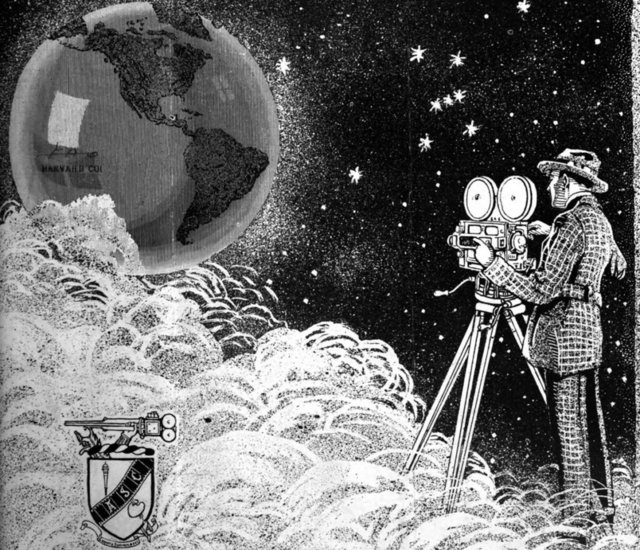
This is an odd little film. I haven't been able to find any info about it at all, including who made it, or were, or when. It's not even listed on IMDB and they usually have even the most obscure films. Judging by the look it probably dates to the mid twenties at the latest. The rest is a guess though.
The film is a straight forward exploration of the solar system as it was known in the twenties, that is before Pluto was discovered. There are quick explanations of the planets and moons, there is also a quick rundown of the Zodiac. What makes the film standout are the cutaways to a fantasy spaceship as it journeys through the universe, along with a stunning shot of a futuristic city that is obviously inspired by Fritz Lang's 1927 classic "Metropolis". The city has all the skyscrapers, domes and elevated trains as flashy as any seen in any bigger budget film for the next twenty years. The spaceship cabin looks more like the cabin of a Zeppelin. This makes me assume the film was made after films like Lang's "Metropolis" (1927) and "The Woman In The Moon" (1929) the Russian film "Aelita, Queen Of Mars" (1924) and the American "Mysterious Island" (1929). The spaceship and space city footage are alone worth seeing for any sci-fi fan. In these sequences the film has some of the look of classic Futurist Expressionism but not obviously it's themes.
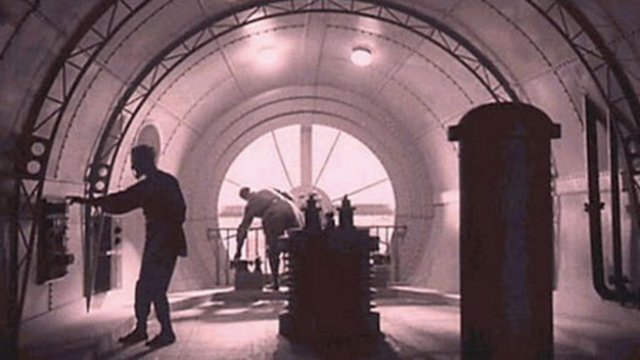
In fact these shots seem so out of place in such a bare bones educational doc that I wonder if they were in fact lifted from another sci-fi movie, or movies, that have since been lost and forgotten. It is actually quite possible that this film was edited together in such a fashion by taking a few scenes from an earlier sci-fi film and splicing in the basic footage of the planets which do appear to have been filmed separately. For further evidence of this note the differences in the title cards between the straight forward exploration of the planets and the more mystical visit through the Zodiac. This film might have been assembled using footage from different countries, the fantasy footage may have indeed come from a forgotten European film (it does look German) while the other footage is probably American since the planets are obviously labeled in English. The footage of the cockpit/bridge actually bears a strong resemblance to an illustration from an obscure 1911 German sci-fi novel called "Wunderwelton" by F.W. Maler with illustrations by D. Herrfurth. Unfortunately this book is so obscure (at least in English) that I can't find anymore info about it aside from a brief mention in a book on Sci-Fi so I don't know how popular it was in 1920's Germany and Austria.

In the silent film days these sort of editing jobs were not that difficult since the lack of sound and the episodic nature of silent film story telling made it possible to to completely rearrange a film into a completely different plot. Given the rather lackadaisical attitude towards copyright in those days, especially international, there was little to stop an unscrupulous American distributors from taking some European footage and making a new film. In fact "Metropolis" was seriously re-edited for it's American release, not only shortening it but also removing some characters and subplots that some Americans might object to. Other characters were seriously changed, including the mad scientist who creates the female robot, to make him less evil. This also explains why some films of the era exist with wildly varied running times for different copies of the same title including DW Griffith's "Birth Of A Nation" and "Intolerance".
One wonders what the audience for this film was. It's obviously not designed for theatrical release but I don't know what kind of venue there would have been for such a doc.
A TRIP TO THE PLANETS;
=============================================================
October 2021 Update; At the time I wrote this article in 2013 I didn't know the history of this film or where it came from and couldn't find any info anywhere but recently someone contacted me with some correct info (thanks BTW) and then I did a little more digging so I'm doing an update/correction although I will leave the original article above here in the interest of transparency.

It turns out that some of my original semi-educated guesses were correct; I assumed this was an edited version of an European, most likely German film for release in America and it was. The original film was called "Wunder der Schopfung" (literally "Wonders Of Creation") also known under the more prosaic title as "Heavenly Bodies" made in Germany in 1925. This film was actually a full-length documentary as part of genre referred to in Germany as "Kulturefilmen" made in the early to mid twenties in the belief that film could be used to only for art and entertainment but also to educate. Most of these films covered topics such as health and fitness (always a German preoccupation), and exploring exotic cultures and locales. Unlike later educational films which were made for classrooms and lecture halls, these films were actually meant to be shown to the general public and were feature length with proper budgets made by major studios like the giant UFA. Several such films were released starting from about 1924 until the end of the silent era so they must have had at least some success although they have been largely forgotten about and ignored by film historians. In his classic work on Weimar Era films "From Caligari To Hitler" (1947) Siegfried Kracauer spends a couple pages discussing the genre and does mention this film but in a way that suggests he had only read about the film rather than actually seeing it while in the other classic work about the era, "The Haunted Screen" (1952) Lotte Eisner doesn't mention the film, or indeed the entire genre at all. Not surprisingly the original German film was considered lost until a copy was discovered in Finland and restored in 2008 with public showings (including in the UK in 2016) although it took a couple years for it to make its way online.
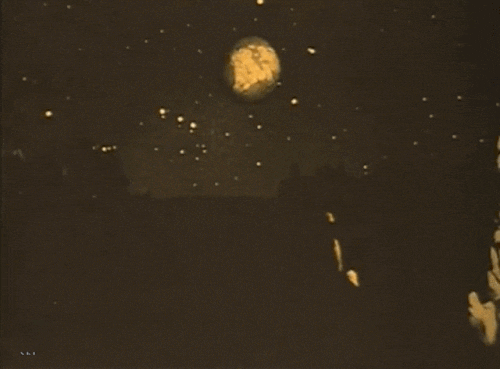
This film was written and directed by Hanns Walter Kornblum for the giant UFA studios which in this case at least gave him a big enough budget and access to the best in their set designers which he clearly made excellent use of. As I mentioned earlier the futuristic spaceship sets and scenes of the planets are spectacular and compare nicely with those of the Fritz Lang classics "Metropolis" (1927) and "The Woman In The Moon" (1929) as well as the Russian sci-fi film "Aelita, Queen Of Mars"and the American 'Mysterious Island" (1929). Although I was correct in my guess about the basic origins of this film I was wrong about one notable thing; I assumed the sets of this film were influenced by these better known sci-fi films when in fact it is actually a few years older than all of them except the Russian "Aelita" and may therefore have instead in fact influenced Lang who must have seen it especially as it seems to have been fairly widely seen in Germany and got good reviews.

The full film is broken down into seven acts in which the opening ones explain the basics of astronomy in a fairly straight-forward way. These scenes have some simple animation along with some recreations of scenes with actors playing scientists like Copernicus, Galileo and Newton. Some of the animation of twinkling stars and spinning planets and moons are dazzlingly effective even today. Scientific concepts like gravity and the rotation of the planets are discussed.
In act four the film leaves the world of dry facts and historical scenes and heads out into space with the spectacular scenes of space flight and a quick shot of a futuristic city including a Tower Of Babel ziggurat launching pad that looks suspiciously like the more elaborate sets later used by Fritz Lang and some starkly beautiful moonscapes. The moonscapes are realistic enough but as our space travellers move further away they become more fantastical. Kornblum's Mars looks more like the deserts of Egypt and somewhat inhabitable, as would the later moonscape of Fritz Lang's "Woman In The Moon". By the time we get to Saturn we encounter a race of desert-dwelling Lilliputians while Jupiter has a race of primitive (but friendly) giants. While these scenes are delightful by this point the film ignores some basic science in portraying these planets as equally habitable. While the film does focus on the different effects of gravity, including scenes of weightlessness, it completely ignores the different atmospheres, some extremely toxic, which make life impossible although scientists by this point understood or at least suspected this. None of our space travelers are required to wear space suits or breathing gear. The film can however be excused to not understanding that such craft would have to be powered through atomic power as this was a new concept understood by only a few scientists and instead has them run by some sort of extra powerful electric generator. This is at least more realistic than the giant cannon used by Jules Verne and George Melies.
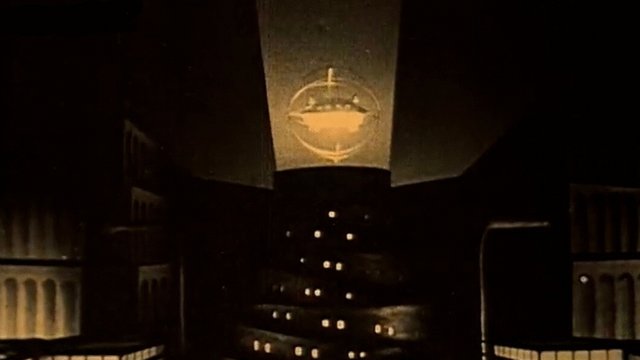
While the film is broadly factual it does have a more mystical theme as implied by the title (every act opens with quotes from philosophers like Goethe and Kant) which becomes more obvious as by the final act we are discussing the end of life on planet earth either through a global ice age (showing our travelers stranded in an Arctic wasteland) or an asteroid crashing into the earth in a sequence apparently inspired by Italian films like "The Last Days Of Pompeii" (1908 & 1913) and various Biblical epics. Viewing the full version of this film reminds one less of the later dry documentaries we are familiar with than the notorious "Haxan, Witchcraft Through The Ages", a 1922 Danish film which Kornblum was almost certainly aware of. Both films are structured in the same way with the early scenes being straight-forward, even dry descriptions of facts and historical recreations before giving rein in later scenes to dramatic fantasy scenes with spectacular special effects.
As for the shorter film "A Trip To The Planets" I originally posted and wrote about; much of it's still a mystery as to exactly who was responsible or exactly when it was done but it seems my original assumptions were correct, it was probably an edited version made in America for educational purposes some time in the late twenties. The English intertitles make it obvious it was done in America and the different typefaces used in some them suggests it may have passed through a few hands. The greatly reduced run time not only cuts out the historical recreations from the early part of the film which slow things down (most educational films were only about twenty minutes long) but also eliminates everything after the visit to Mars, much of which is more speculative and fantastical then the early parts of the film and perhaps not really appropriate for a purely educational film anyway. While the American version takes out the philosophical elements from the original German film it does add in some of it's own as it takes pains to insist that it's science is compatible with the Bible and the Book Of Genesis. It must be remembered that the 1920's was the era of the Scopes Trial in 1925 and laws banning the teaching of evolution in many states so equating science with Christianity would avoid getting the film banned in parts of America.
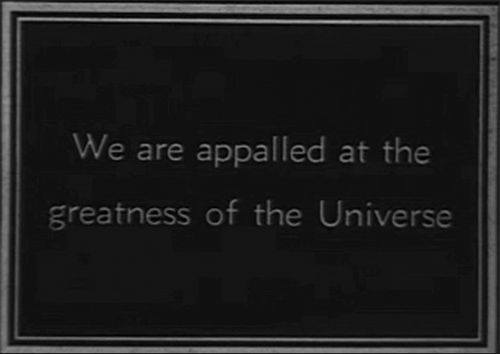
Since my original 2013 article more research has been done on this intriguing little film which seems to fascinate people. The only known copy has been held by the fine folks at Prelinger Archives who included it in a 2012 DVD of "Orphan Films" meaning films about which little or nothing is known about their creators. By this time the original German film had been found and restored and had been shown in Germany although this news had apparently not yet reached Prelinger in America. By this year (2021) Prelinger had been informed about the existence of the original film and likely relationship to the short in their archives and presented this with some further research in a February panel discussion and blog article.

The original German film was produced by the giant UFA film studios who exported films world wide however this one does not seem to have been shown much outside the German speaking world although since the surviving copy was found in Finland it must have been exported at least to Scandinavia. Films of the Weimar often made their way there as well to Russia and Holland where copies sometimes turn up. UFA also had an export office in America and USA distribution contracts with MGM and Paramount and a search through UFA records (which being German still exist thankfully) do not show any copies being shown in America nor have any press reviews surfaced. However in 1927 MGM does indeed list a one reel "UFA oddity" named "Heavenly Bodies" which is also an alternative title the German original was sometimes known by. As this is a one reel short however it can not be the original so the assumption Prelinger makes is that it's the short version we now have which had been edited down to be used as an educational short which may be true but it might also be another related short I will mention below. Some of these films, if well made and attractive, which this one was, were actually shown as opening shorts to feature films and weekend matinees along with the usual comedy shorts and cartoons before being sold or rented to schools, universities, libraries, church groups etc depending on the subject matter. These rentals were not done by a major studio like MGM however, once MGM was done showing the film in theaters they then sold the rights to smaller distributors who specialized in educational shorts in this case the rights to a company called the Mogull Brothers who probably redited it and made some changes. It's possible that some of the still footage of the surface of the moon was was actually lifted from an American short "If We Lived On The Moon" which we will explore shortly. At this point the title card was changed to "A Trip To The Planets". This would explain the obviously different typefaces used in the film, they may also have added the Bible references to make the film sellable in the Bible Belt. This particular one is listed in school and library rental catalogues until 1945 after which it disappears. Such films often sat in dusty shelves and cabinets in schools and libraries for decades forgotten by film historians before getting purged in the 1980's when schools moved to VCRs. Prelinger Archives, working with the Library of Congress bought the surviving copy of this film along with hundreds of others from the Mogull Bros collection in 2009 but at the time nobody was aware of the film's complicated past.
It turned out that once Prelinger found out the history of this film they discovered there were not one but at least two educational shorts made from the original and they actually had both in their archives the whole time. The other short was billed as "Heavenly Bodies" and must have been assembled around the same time and may be the film mentioned in the above MGM press release although this film seems a little too dry to be worth plugging for a general release compared to "A Trip To The Planets" if that film had been renamed at some point. At any rate this edit discusses gravity by taking the Issac Newton scene from the original along with the comedy scene with a man grabbing a tree to avoid being shot into space. The second half of the film deals with astronomy. This short is fine for it's purpose and is actually more coherent than "A Trip To The Planets" which is more jumbled but lacks entirely it's sense of style and wonder. It's also a poor quality print.
"HEAVENLY BODIES";
The genre of Kulturefilmen petered out with the coming of sound and a desire of audiences for more escapist entertainment meant a big studio like UFA would have little interest in big budget docs and film houses even less interest on showing them. At any rate with the Nazis coming to power such high-minded educational fare would give way to an entirely different and far more sinister type of film as propaganda. There is not much information on director Hanns Kornblum who died in Germany in 1970. He could have continued to make obscure educational or industrial film shorts which have been long forgotten and not listed on IMDB or worked on other films as an editor but we do know he would make at least one more film a year later about Einstein's new Theory Of Relativity which did not survive (the Nazis would have definitely banned it) but once again it would make its way to America where another edited version would be cut.
"THE EINSTEIN THEORY OF RELATIVITY" (1923);
While we don't have much info on who adapted "A Trip To The Planets" we do have know who is responsible for this film as it was assembled by none other than famed animators Dave and Max Fleischer, later creators of the iconic Betty Boop, Popeye and Superman cartoons. Brothers Max and Dave Fleischer had been working as ground breaking animators since 1918 having previously worked as film editors for Pathe Films and making educational short films for the US Army in World War One and afterwards for a company named Bray Pictures who made educational shorts. By 1922 they had established their own studio. They were given the assignment of adapting Kornblum's original film for America to explain Einstein's new, controversial and complicated theory. Since we don't have the original we don't know how they much they changed or cut out or how long the original was but reportedly they did add a few animated sequences themselves and at least some of the filmed footage since the city shown is clearly New York. Possibly they only used a small part of the original Kornblum film now lost. Compared to the previous film with it's spectacular futuristic sets and dramatic recreations this film is very dry and no-nonsense with plenty of title cards and doesn't really compare with the dreamy charm of Kornblum's previous film or for that matter the well known cartoons that make up the huge and beloved library of the Fleischer Bros Studios for which this merely an odd curio.
Bray Studios was founded by John Bray in 1912 and would make a name for itself as a producer of early cartoons employing some later famous animators like the Fleischer Bros, Walter Lanz ("Woody Woodpecker") and Paul Terry ("Terrytunes"). John Bray himself had been an early animator and was heavily influenced by the brilliant pioneer animator Winsor McCay and his groundbreaking shorts of the 1910's like "Gertie The Dinosaur" with McCay himself teaching him some of his methods only to have Bray go behind his back and try to patent them (which McCay had at first generously chosen not to do being happy to encourage other cartoonists) and then had the nerve to sue McCay for violating the patents on his own inventions! McCay would end up winning those suits but it set a patern of Bray's hard driving, not to mention greedy business attitudes. Besides cartoon Bray also tried his hand at making comedy shorts and branched out into the lower profile but lucrative genre of educational, promotional and industrial films including for clients like the auto industry and the US Army. Bray would spend less time on animation to focus on running the business including cutting a deal with Sam Goldwyn in 1920 which gained Bray Studios more money and major distribution but also a heavier workload which along with Bray's penny-pinching would lead his best animators, the Fleischers, Lantz and Terry to leave and found their own studios. Bray's lucrative ad contracts including those for the automotive industry were managed by producer and former Olympic swimmer Jam Handy would eventually leave as well in the 1930's to start his own studios as well taking most of his clients.
While working at Bray Pictures the Fleischer Bros also worked on another educational space short around 1920 to 21, since by 1922 they had their own studios, called "If We Lived On The Moon" which exists in two seperate but obviously related shorts, one uses mostly animated footage and minatures while the other uses live action and painted stills, there are a few shots that are the same in both shorts (namely a sequence using miniatures to show the difference in temperature between night and day on a lake) and given the brief length of both (three and a half minutes for one and four minutes for the other) it's likely they were originally edited as together as one longer film but it's hard to see why they were cut into two.
"IF WE LIVED ON THE MOON" pt.1 (crica 1921);
Another clue that the two shorter films must have been part of a longer one is a promo poster put out by Bray Studios that shows a striking illustration of New York City inside a giant moon crater which does not appear in either of the two fragments we have left so given the usual length of such films there must be at least ten minutes of lost footage. Although as we shall see while the full length version of this film may have been lost for some reason this tiny part of it would find itself recycled.
"IF WE LIVED ON THE MOON" pt.2 (animated);
The animated version shows the Fleischer Bros fine draughtmanship, attention to detail and Art Deco influence that would later be seen in their iconic "Superman" cartoons of the 1940's. This is also the only one of these films to aknowledge that there is no atmosphere in space and man can not breathe although their solution of a heavy fur coat, hat and World War One gasmask is more appropriate to a high flying Zeppelin on an Arctic journey than space travel.
"TIDES & THE MOON";
Little is known about this short including when it was made although it appears to be of the same vintage judging by the Bray logos used so it may have been done at the same time as the other Bray space shorts however the workmanlike animation has none of the stylishness of the Fleischer Bros though so it's impossible to know who worked on it. As the title suggests it's not about space travel itself although it does have some sequences showing the orbits of the Earth and the Moon.
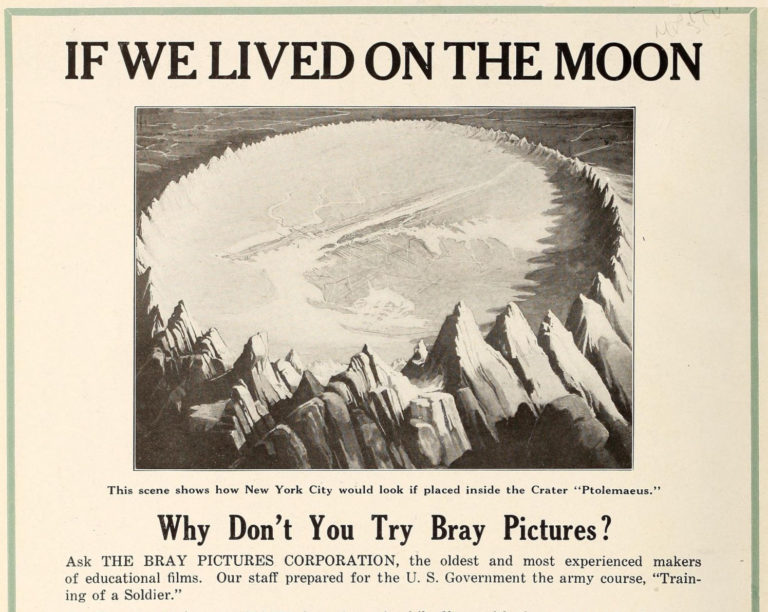
Bray Studios shut down it's commercial animation and it's not terribly successful comedy series with the advent of sound in 1928 to focus on documentary and educational films into the 1960's when they scaled back continuing to distribute into the 1980's. Bray himself died in 1978 aged 99. ~~~~~~~~~~~~~~~~~~~~~~~~~~~~~~~~~~~~~~~~~~~~~~~~~~~~~~~~~~~~~~

By comparison to these films here we have two contemporary American educational films dealing with some of the same subjects in a more straight-forward and far less artistic way showing again the difference between the German feature, which was made for a general audience by craftsmen who had some sort of artistic vision and even the playful Fleischer Bros short to the more workmanlike films made for purely educational purposes. Unfortunately no names of any actual people involved in these films such as directors are listed.
"THE SKY" (1928);
This film was made by DeVry School Films who were a major producer of educational films in the twenties, a look at 1926 guide book for educators listing films available for schools and libraries from numorous companies (including US government departments) has dozens of films from DeVry on various subjects. Founder Herman DeVry was a German immigrant and an inventor and friend of fellow inventor the notorious Lee Deforest who claimed to have invented radio and television (he did not). He was one of the pioneers of educational films and later went on to found the well known DeVry Universities as a chain of private technical colleges across the country which still exist. He died in 1941.

This one has some good photography including some nicely moody shots of a youth looking at the stars, shots of an observatory and the usual fine shots of stars and planets, including a spacey shot of a window shade opening itself to reveal the stars. A more interesting thing I noticed is a shot of New York City sitting in a crater that is clearly the same as the one on the poster from the Bray Studios "If We Lived On The Moon" a half dozen years earlier so DeVry must have bought the now lost footage from Bray Studios and recycled it as the shots of the moon's surface are also the same. Also interesting is that some of the intertitles seem to be identical to some of those from "A Trip To The Planets" and since we know that film is a few years older that confirms the impression given by the rather choppy nature of that film and the wildly different typefaces used throughout that it must have been redited more than once over the years. Perhaps by Mogull Bros when the bought the rights from MGM. As for "The Sky"; it may not have the artistic and philosophical ambitions of the German films or even the Fleischer Bros but it is more consistantly coherant in telling its narrative and quite watchable.
"THE EARTH" (1928)
Our next one was made in 1928 by a studio named the Neighborhood Motion Picture Service who specialized in educational short films. At least one more of their films survives and it's a bland film about nutrition made for public schools and a listing I found of film copyrights for 1927 shows them as a New York based studio with four other nature and gardening documentaries. The guide book for educators lists a few more on from this company on citizenship and American history although no more on science (at least at that time) making them a respectable but minor player in the business. Only the first half of this film is actually about space although it does have some nice shots of a solar eclipse. Once again the shot of New York City sitting in a crater from Bray Studios is back. The rest of the film is normal live action and illustrations about the earth's surface along with a scene showing how to view an eclipse by looking at the sun from behind a grapefruit (note; Do Not Try This) and footage of what appears to be the grand canyon. While this film is low budget and much of it was probably patched together from existing footage it is once again efficient and on topic with some good visuals.
"A TRIP TO THE MOON" (circa 1926);
We know even less about this film. The company, Service Pictures, has such an anodyne name that trying to track down any info seems pointless as does any attempts to chase down the equally bland title. Given the fly-by-night nature of some of these tiny studios it's possible it operated under other equally forgettable names. Nonetheless this film does have it's charms as it's story gives some fanciful history of some pre-modern claims of space travel. This animation is very crude consisting of merely sliding paper spaceships across a backdrop and barely qualifies as animation at all but they do have a childlike sense of fun. The drawing of a futuristic spacecraft (in the year 1999) actually looks more realistic than the better drawn Fleischer rocket and was probably based on a diving bell. The shot of the spacecraft leaving a futuristic city and floating in space shows a likely infuence from the 1925 German film albeit done on a much smaller budget and looks almost like an amateur Kubrick with the cratered moonscape looking more gritty and harsh than the other films although it does not explain the moon's lack of atmosphere. This film also makes no attempt to explain how the spacecraft might work and seems quite unaware about the rock experiments Robert Goddard was even then working on. A sequence showing the passing of time starts in 1926 suggesting that was when it was made but that's just a guess although it's clearly not made after that date. While this film actually has precious little actual scientific information it is quite watchable unfortunately we know nothing about those who made it.

"A SOLAR ECLIPSE OVER NEW YORK" (circa 1920's)
Our last film is a fragment from an unknown longer film showing a solar eclipse over New York state as we track it from Buffalo to Poughkeepsie to New York City. The eclipse is shown using a combination of actual footage and simple animation over skyline footage and looks fairly effective. We also see footage of an early observatory telescope outside Buffalo. There's no other inforation about this film including exactly who made it, when, or how long the entire film was. This fragment was found in Holland so the intertitles are in Dutch but's almost certainally an American film and says Universal across the bottom on the intertitles.
Note that by this point talkie films were starting to be made in Hollywood although that would have had no effect on the targeted audience for films for schools and libraries which would have still have been using silent projectors for several more years especially once the Great Depression hit and school budgets got cut. Some of these films were likely still in use into the 1960's.
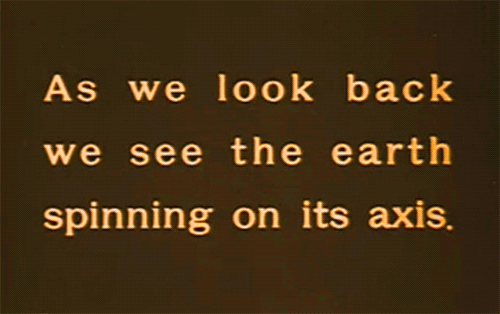

No comments:
Post a Comment